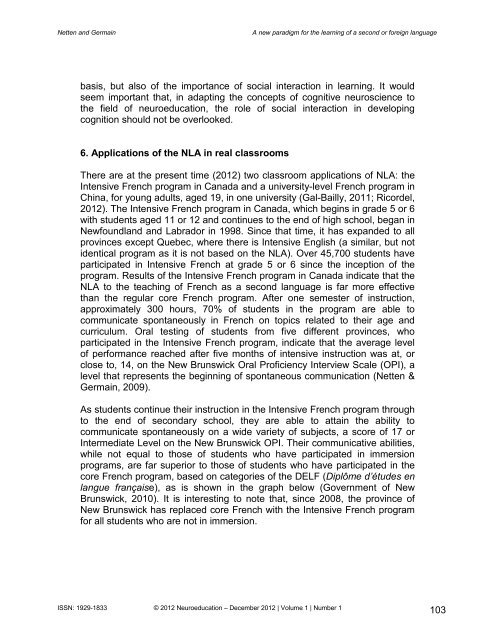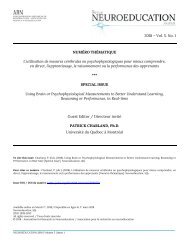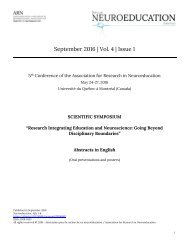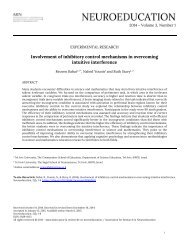Neuroeducation_2012_vol-1_no-1_full
Neuroeducation journal - Volume 1, Issue 1 (2012) - 144 pages
Neuroeducation journal - Volume 1, Issue 1 (2012) - 144 pages
Create successful ePaper yourself
Turn your PDF publications into a flip-book with our unique Google optimized e-Paper software.
Netten and Germain<br />
A new paradigm for the learning of a second or foreign language<br />
basis, but also of the importance of social interaction in learning. It would<br />
seem important that, in adapting the concepts of cognitive neuroscience to<br />
the field of neuroeducation, the role of social interaction in developing<br />
cognition should <strong>no</strong>t be overlooked.<br />
6. Applications of the NLA in real classrooms<br />
There are at the present time (<strong>2012</strong>) two classroom applications of NLA: the<br />
Intensive French program in Canada and a university-level French program in<br />
China, for young adults, aged 19, in one university (Gal-Bailly, 2011; Ricordel,<br />
<strong>2012</strong>). The Intensive French program in Canada, which begins in grade 5 or 6<br />
with students aged 11 or 12 and continues to the end of high school, began in<br />
Newfoundland and Labrador in 1998. Since that time, it has expanded to all<br />
provinces except Quebec, where there is Intensive English (a similar, but <strong>no</strong>t<br />
identical program as it is <strong>no</strong>t based on the NLA). Over 45,700 students have<br />
participated in Intensive French at grade 5 or 6 since the inception of the<br />
program. Results of the Intensive French program in Canada indicate that the<br />
NLA to the teaching of French as a second language is far more effective<br />
than the regular core French program. After one semester of instruction,<br />
approximately 300 hours, 70% of students in the program are able to<br />
communicate spontaneously in French on topics related to their age and<br />
curriculum. Oral testing of students from five different provinces, who<br />
participated in the Intensive French program, indicate that the average level<br />
of performance reached after five months of intensive instruction was at, or<br />
close to, 14, on the New Brunswick Oral Proficiency Interview Scale (OPI), a<br />
level that represents the beginning of spontaneous communication (Netten &<br />
Germain, 2009).<br />
As students continue their instruction in the Intensive French program through<br />
to the end of secondary school, they are able to attain the ability to<br />
communicate spontaneously on a wide variety of subjects, a score of 17 or<br />
Intermediate Level on the New Brunswick OPI. Their communicative abilities,<br />
while <strong>no</strong>t equal to those of students who have participated in immersion<br />
programs, are far superior to those of students who have participated in the<br />
core French program, based on categories of the DELF (Diplôme d’études en<br />
langue française), as is shown in the graph below (Government of New<br />
Brunswick, 2010). It is interesting to <strong>no</strong>te that, since 2008, the province of<br />
New Brunswick has replaced core French with the Intensive French program<br />
for all students who are <strong>no</strong>t in immersion.<br />
ISSN: 1929-1833 © <strong>2012</strong> <strong>Neuroeducation</strong> – December <strong>2012</strong> | Volume 1 | Number 1<br />
103








